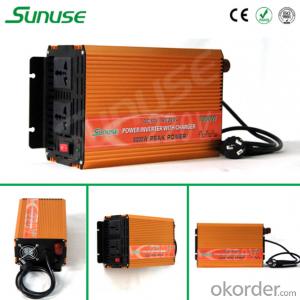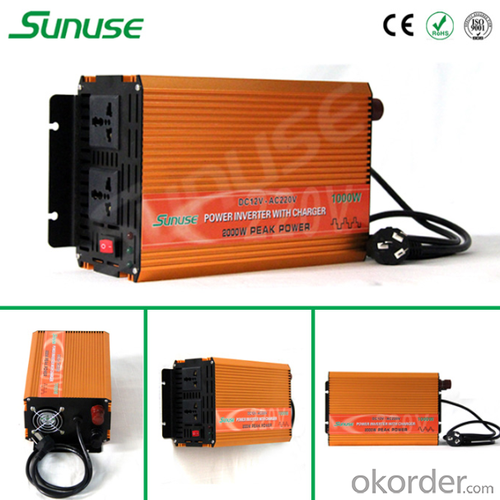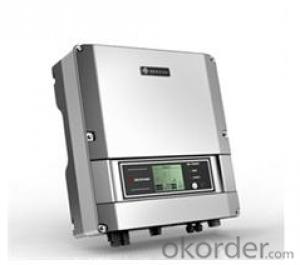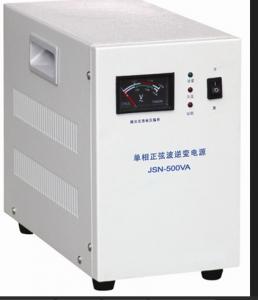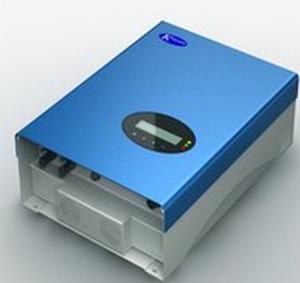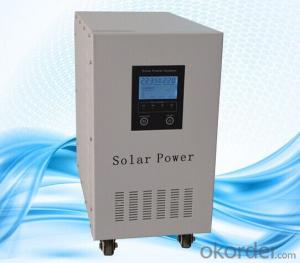Fimer Solar 1000W Home UPS Inverter 12V 220V with UPS Function
- Loading Port:
- Qingdao
- Payment Terms:
- TT or LC
- Min Order Qty:
- 50 unit
- Supply Capability:
- 30000 unit/month
OKorder Service Pledge
OKorder Financial Service
You Might Also Like
1. Structure of 1000W Home Ups Inverter, Inverter 12V 220V 1000W with Ups Function Description
A solar inverter, or PV inverter, or Solar converter, converts the variable direct current (DC) output of a photovoltaic (PV) solar panel into a utility frequency alternating current (AC) that can be fed into a commercial electrical grid or used by a local, off-grid electrical network. It is a critical BOS–component in a photovoltaic system, allowing the use of ordinary AC-powered equipment. Solar inverters have special functions adapted for use with photovoltaic arrays, including maximum power point tracking and anti-islanding protection.
2. Main Features of the 1000W Home Ups Inverter, Inverter 12V 220V 1000W with Ups Function
﹒Convert 12V/24V DC to 220V/110V AC to supply for the electronic products such as player MP3, player MP4
﹒DC 12/24V to AC 110/220V
﹒1000W home ups inverter
﹒Inverter 12v 220v 1000w with ups function
3. 1000W Home Ups Inverter, Inverter 12V 220V 1000W with Ups Function Images
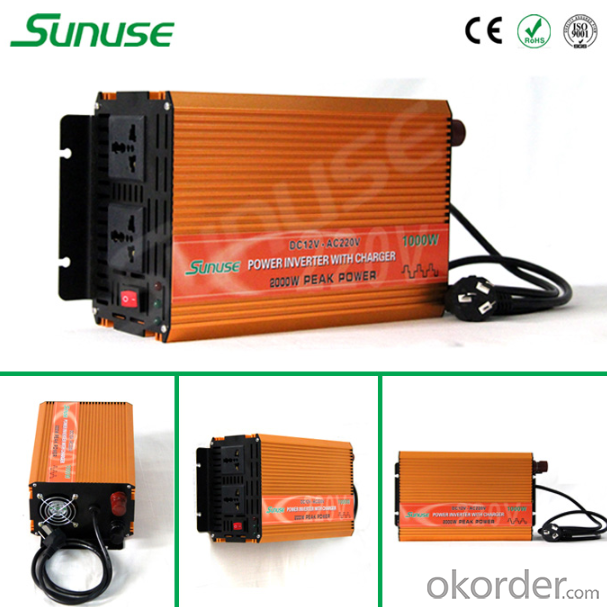
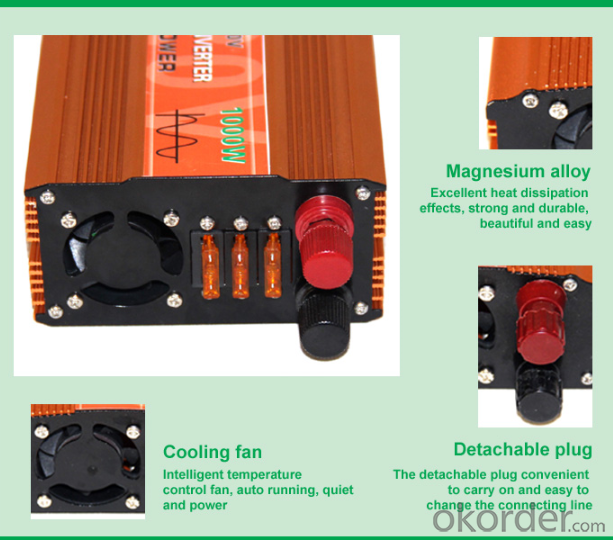
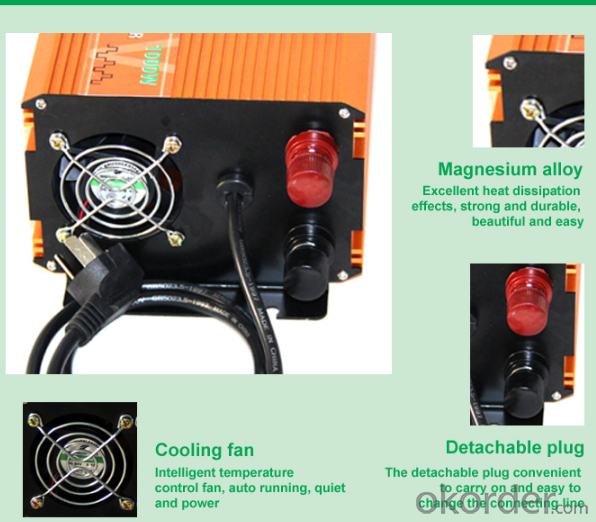
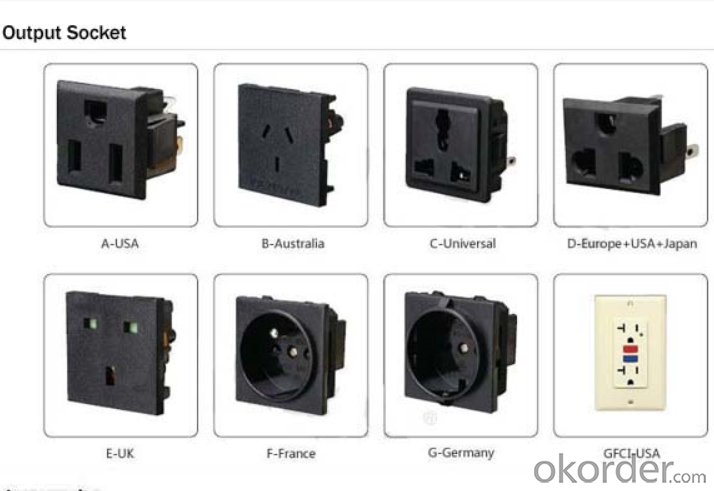
4. 1000W Home Ups Inverter, Inverter 12V 220V 1000W with Ups Function Specification
Input part | |
DC voltage: | 12V or 24V |
Voltage range: | 10-15VDC or 21-30VDC |
No load current draw: | <0.3a< span=""> |
Efficiency: | >92% |
DC connection: | Cables with clips |
Output part | |
AC voltage: | 100-120V or 220-240V |
Frequency: | 50Hz/60 Hz |
Continuous power: | 1000W |
Surge power: | 2000W |
Wave form: | modified sine wave |
AC regulation: | 3% |
Charge part | |
Charge current: | 10A |
Charge voltage: | 12V/24V |
Charge mode: | Three-gradation |
Protection part | |
Low voltage alarm: | 10DC±0.5V or 20.5DC±1V |
Low voltage shut down: | 9.5DC±0.5V or 19.5DC±1V |
Over load: | shut off output |
Over voltage shut down: | 15.5V or 30.5V |
Over thermal | shut off output automatically |
Environment part | |
Working temperature: | between -10°C and +50°C |
Working humidity: | 20% ~ 90% RH |
Storage temperature: | between -30°C and +70°C |
Package part | |
Machine size: | 235*150*100mm |
Packing size: | 355*250*163mm |
Net weight: | 2.55kg |
Gross weight: | 2.85kg |
Packing: | carton packaging |
Other part | |
Start: | soft start |
Cooling ways: | intelligent cooling fan |
5. FAQ of 1000W Home Ups Inverter, Inverter 12V 220V 1000W with Ups Function
Q1. What is the difference between inverter and solar inverter?
A1. Inverter only has AC inpput, but solar inverter both connect to AC input and solar panel, it saves more power.
Q2. What is the difference between MPPT&PWM?
A2. MPPT has higher efficiency, it can track the max power point and won't waste energy.
Q3. What is the waranty of product?
A3. 12 months.
- Q: Can a solar inverter be used with a solar-powered EV charging network?
- Yes, a solar inverter can be used with a solar-powered EV charging network. A solar inverter is responsible for converting the direct current (DC) produced by solar panels into alternating current (AC) that can be used to power electrical devices, including EV chargers. By integrating a solar inverter into a solar-powered EV charging network, the energy generated by the solar panels can directly power the charging stations, reducing reliance on the grid and promoting sustainable energy use.
- Q: How do you calculate the efficiency of a solar inverter?
- To calculate the efficiency of a solar inverter, you need to divide the output power by the input power and multiply it by 100. The formula is: Efficiency = (Output Power / Input Power) * 100.
- Q: How do you choose the right size of solar inverter for a solar power system?
- To choose the right size of solar inverter for a solar power system, you need to consider the total capacity of your solar panels and the maximum power output they can generate. The solar inverter's capacity should be equal to or slightly higher than the maximum power output of your solar panels to ensure optimal performance and efficiency. Additionally, you should also consider any future expansion plans for your solar power system to account for potential increases in capacity. It is recommended to consult with a professional solar installer or engineer to accurately determine the appropriate size of the solar inverter for your specific requirements.
- Q: How do you calculate the maximum power point current for a solar inverter?
- The maximum power point current for a solar inverter can be calculated by using the maximum power point tracking (MPPT) algorithm. This algorithm constantly adjusts the operating conditions of the inverter to maximize the power output from the solar panels. It does this by varying the input voltage and current to find the point at which the power output is at its highest. This maximum power point current can be determined using mathematical calculations and algorithms employed by the solar inverter.
- Q: Why is a solar inverter necessary in a solar power system?
- A solar inverter is necessary in a solar power system because it converts the direct current (DC) produced by solar panels into alternating current (AC) that can be used to power household appliances and be fed back into the grid. Without a solar inverter, the DC power generated by solar panels would be incompatible with the electrical grid and unable to be utilized effectively.
- Q: Can a solar inverter be used with both AC and DC power sources?
- No, a solar inverter is designed to convert DC power generated by solar panels into usable AC power for household or grid consumption. It cannot be used directly with DC power sources.
- Q: What is the role of a grid monitoring feature in a solar inverter?
- The role of a grid monitoring feature in a solar inverter is to constantly monitor the electrical grid for voltage, frequency, and other parameters. This feature ensures that the solar inverter is synchronized with the grid and operates within the specified limits. It helps in maintaining a stable and reliable connection between the solar system and the grid, preventing any damage to the inverter or the grid. Additionally, grid monitoring also enables the solar inverter to detect any faults or abnormalities in the grid and take appropriate measures to protect the system and ensure safe operation.
- Q: What is the role of a voltage control unit in a solar inverter?
- The role of a voltage control unit in a solar inverter is to regulate and stabilize the voltage of the direct current (DC) power generated by the solar panels before it is converted into alternating current (AC) power. It ensures that the voltage remains within the desired range to optimize the efficiency and performance of the solar inverter, as well as protect the connected appliances or grid from potential damage due to voltage fluctuations.
- Q: Can a solar inverter be used in a smart grid system?
- Yes, a solar inverter can be used in a smart grid system. A solar inverter is an essential component that converts the direct current (DC) generated by solar panels into alternating current (AC) that can be used to power electrical devices. In a smart grid system, the solar inverter plays a crucial role in integrating renewable energy sources, such as solar power, with the grid. It allows for bidirectional flow of electricity, enabling excess energy generated by solar panels to be fed back into the grid and distributed to other consumers. Additionally, advanced smart grid systems can incorporate communication and control capabilities into solar inverters, enabling real-time monitoring, optimized energy management, and grid stability enhancement.
- Q: Can a solar inverter be used for both grid-tied and off-grid systems?
- Yes, a solar inverter can be used for both grid-tied and off-grid systems. However, it is important to note that there are different types of solar inverters designed specifically for each system. Grid-tied inverters are designed to convert DC power generated by solar panels into AC power and feed it into the grid, while off-grid inverters are designed to convert DC power into AC power for use in standalone systems not connected to the grid.
Send your message to us
Fimer Solar 1000W Home UPS Inverter 12V 220V with UPS Function
- Loading Port:
- Qingdao
- Payment Terms:
- TT or LC
- Min Order Qty:
- 50 unit
- Supply Capability:
- 30000 unit/month
OKorder Service Pledge
OKorder Financial Service
Similar products
Hot products
Hot Searches
Related keywords
